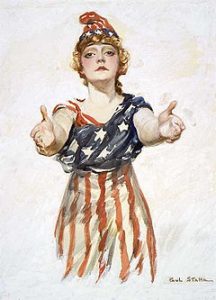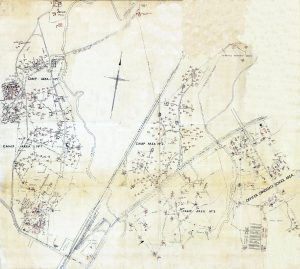Americans enter the war in the South-West Pacific

After the disastrous bombing of Pearl Harbor on 7 December 1941, the US rapidly entered the Allied WWII effort and took leadership in the Pacific. General MacArthur had fled the Philippines and set up his office in Melbourne. However, in order to be closer to the theatre of war, a few months later, he set up his Pacific HQ in Brisbane. His personal office was in town, now the MacArthur Building in Queens Street.
US service men arrived in Brisbane from where they were send to the various battlefields in the Pacific. Their transfer camp – set up by US Army Service of Supply (USASOS) – was in Victoria Park on the edge of the central business district. During the war close to 100,000 American soldiers passed through the Brisbane camps.
Staging Camp in Wacol
A large area in and around Wacol – which was nearly all bush land at that time – was selected as its major staging camp for the US Army in the South West Pacific. Here weapons, ammunition and equipment in transit were assembled or processed. A range of military facilities were build in the area which were all managed from the headquarters at Camp Columbia.
Part of what became Camp Columbia – close to Brisbane River – was already since 1940 used by the units from the nearby Redbank Camp of the Australian Army for Bren Gun manoeuvres.
The closest civil (farming) communities to Camp Columbia where Darra, Richlands and Inala. Many people were able to profit from the enormous influx of Americans into their area. They opened fresh produce stall and shops to cater for these new customers, there was a high demand for produce, and the Americans paid well.
Many women were involved in washing for the army (some offered more private services) or simply fell in love with the visiting soldiers. There are plenty of stories about local girls in Brisbane’s South West to have born children from the soldiers, including black ones. Several also married their soldier lovers, traveled to the USA and often afters years came back with or without their husbands. In all 16,000 of the one million American war brides came from Australia and 7,000 of them from Queensland.
Camp Columbia
The site selected for Camp Columbia was close to (the old) Ipswich Road and the Wacol railway station. It had three sections:
- Camp 1, west of Sandy Creek, north of Grindle Rd towards Wolston Creek
- Camp 2 , east of Sandy Creek, between the railway and Ipswich Road
- Camp 3, between Sandy Creek and Bullock Head Creek, south of Ipswich Road.
The site was selected because it had large government reserves and was close to the Wacol railway station. The aging and poorly maintained railways system became the major transport corridor to the northern parts of Australia for the supply of bombs to the various airports that were set up by the American forces. Often thousands of bombs were stored in the railway yard waiting to be transported north.
Australian Builder and Civil Engineer.Manuel Hornibrook was selected by the Americans to build many of the buildings required by the military. The camp would have to be able to house 5,000 staff. He brought together over 50 local Brisbane builders for the construction. He designed the camp in such a way that it could be used after the war for shearers’ quarters on station properties. In the end it were refugees and migrants who benefited from his foresight. The Hornibrook company also constructed the Story Bridge and the Hornibrook Highway (Bridge). The headquarter buildings were constructed using timber with asbestos cement (fibrolite) cladding.
The top of a hill along Wacol Station Road was earmarked for the Camp’s headquarters. This comprised administrative offices, barracks, accommodation huts and an internal road network.
The first unit stationed at Camp Columbia was the 738th Military Police Battalion, they arrived here omn the 9th of August 1942. In Brisbane this division received notoriety during the Battle of Brisbane (26 November 1942) between (overpaid, overdressed and oversexed) US soldiers and their Australian counterparts.
In April 1943 Camp Columbia also became the headquarters of the Sixth United States Army. This is the theater army of the United States Army and was formed in Australia at Camp Columbia. It was activated in January 1943, commanded by Lieutenant General Walter Krueger. Under the code name Alamo Force, it assumed control of the majority of US Army units involved in Operation Cartwheel, the campaign to isolate and neutralise the Japanese base at Rabaul in New Britain. Following the completion of Cartwheel, Sixth Army joined Australian Army and other US forces on the north coast of New Guinea. Similar in conception to the island hopping operations of the central Pacific, the object of the attacks was to land, establish a garrison and airfield which could support the next strike, and then move on.
At Camp Columbia they had their offices and living quarters on the north-eastern side of the land. The US army stayed here till 1944, after which the Dutch took over the Camp.

There was no infrastructure in Wacol but within weeks canvas water pipes were connected to the water supply in Darra; electricity infrastructure was also built, again linked to the facilities in Darra. Over the following months significant extra infrastructure was developed. The main roads used by the military from Wacol to the railway station and the airfield were sealed. A large sewerage system was built on the western side of Wacol. People in Brisbane complained that the military and later the refugees and migrants that used the camp had a better sewerage system than people in town.
Return to Camp Columbia Heritage Park, Wacol, Brisbane TOC